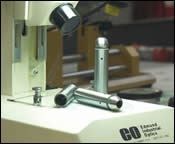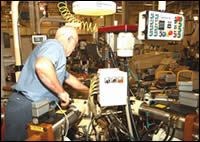Rotary Transfer Machines Help Shop Make Transition
Camcraft Precision Machined Components purchased two rotary transfer machines from Hydromat Inc. after winning a bid on an automotive plunger.
This article has been adapted from the original, which was written in 2004.
It’s a chicken and egg situation: You can’t compete successfully for today’s high-volume automotive jobs if you don’t have the right equipment, but you need one or more of today’s high-volume automotive jobs to justify the purchase of that equipment. That was the dilemma facing Camcraft Precision Machined Components (Hanover Park, Illinois) as it maneuvered to capture a bigger chunk of the automotive parts market.
Several years ago, Camcraft had an opportunity to bid on an automotive plunger. The plunger had a sphere on one end that required a 32-RMS finish. Four holes had to be spaced around the OD of the part at exact locations relative to sphere’s center line. Initially, the company bid the job on the basis of blanking the part on its New Britain multi-spindle screw machines and then drilling the holes and single-point turning the sphere’s OD to achieve the required surface finish as secondary operations.

Camcraft chose CNC rotary transfer machines for their flexibility. For example, they were used to single-point turning the ball on the end of this plunger to achieve the required surface finish without a secondary operation.
Camcraft did not have much confidence in its bid, however. The part was similar to other parts that the company had bid for previously, and the winning bids were well below what it had bid for the plunger. The company decided to rebid the job, this time on the basis of machining the plunger complete in one setup on a rotary transfer machine. Volume requirements were about 2 million pieces annually, and if it was awarded the job, it would purchase two rotary transfer machines, each of which would produce 1 million parts annually.
“Until that time, there had been no reason for us to consider purchasing such machines,” explains Marc Bossert, Camcraft’s engineering manager. “However, the large production quantities that the job involved justified the investment. More to the point, we had considered all of the options and were convinced that a rotary transfer machine was the best machine for the job—and our best chance of getting the job.”
Camcraft won the job and, after comparing the rotary transfer machines available on the market, it purchased a pair of HW 25-12 CNC rotary transfer machines from Hydromat Inc.
“In the past, most of our jobs involved smaller volumes, and it would have been difficult to justify buying such a machine for them,” Mr. Bossert says. “Once we found a part that involved sufficient volume—one that would tie up two rotary transfer machines for a considerable period—the purchase was a no-brainer.”
The acquisition of the rotary transfer machines represented a significant milestone along the company’s road to becoming a major automotive parts producer.
The Machine
The HW 25-12 CNC rotary transfer machine is a modular system consisting of 12 horizontal and up to six vertical tool spindle units. It can produce parts from barstock or discrete blanks up to 1 inch in diameter. Each of the machines sold to Camcraft is equipped with a magazine bar feeder that feeds stationary (non-rotating) bars into the machine for processing.
The bar advances to the first station, where it is gripped in a collet and a blank of desired length is cut off. Held in the collet, the blank travels around on the machine’s indexing table and is presented to each station in turn for such operations as drilling, cross-drilling, boring, turning, milling, threading, tapping and broaching. The operations are performed simultaneously at all workstations, and each time the table indexes, a completely machined part drops off.
All tool spindles are modular and provide maximum interchangeability for retooling. The modular toolhead system provides full flexibility to change machining operations (from drilling to turning to milling) simply by changing the quick-change toolhead attached to the end of the tool spindle. The quick-change system provides quick, easy tool changing for worn-tool replacement or complete job change-overs.
A standard feature of the machine is an inverting unit that removes the workpiece from the collet, turns it end for end and puts it back in the collet. This enables both ends of the part to be completely machined in one setup.
The servo control executes motion control programs in a multitasking environment handling up to 40 independent axes.
Another impressive feature of the machine is its servo-controlled CNC technology. CNC servo units can be mounted horizontally, vertically or both ways at a given station. General machine control is provided by a GE FANUC programmable control. However, open architecture allows a PC located at the machine to interface with programmable multi-axis servo controls. Motion control programs are processed on the PC and transferred to the servo controls via the GE FANUC. The servo control executes motion control programs in a multitasking environment handling up to 40 independent axes. The servo positioning drive package consists of proportional valves for each of the tool spindle units.
The system’s user interface is a Windows program that makes machine programming an easy, time-efficient task. The machine operator is not required to understand programming languages because the interface is entirely menu-driven.

Requirements by the customer for zero defects means operator Pat McEvoy must closely monitor the rotary transfer machine’s operation and be ready to take corrective action should parts start drifting toward an out-of-tolerance condition.
CNC part programs can be developed by the operator while the machine is running. They can be automatically generated simply by entering feed rates and position moves. Tool offsets can be adjusted on the fly. The CNC provides full-control, single-point machining using two-axis interpolations to generate radii or form requirements, eliminating the need for form tools. Single- or dual-axis hydraulic servo technology uses precision components in a closed-loop system, providing continuous feedback for consistent accuracy and repeatability.
Reasons for Choosing CNC
“The HW 25-12 is available in a hydraulically controlled version, but we chose the CNC version to machine the plunger for a number of reasons,” Mr. Bossert explains. “With the hydraulically controlled version, we would have needed a form tool to machine the spherical end of the plunger, and we wouldn’t have been able to achieve the required 32-RMS finish in the part’s 8620 material, which is gummy, stringy and tears easily. With the CNC machine, we are able to single-point turn the spherical end to the required surface finish. We hold some difficult surface finishes on the part ID as well.
“If we had to drill the holes in the plunger as a secondary operation, it would have been difficult to locate the holes relative to the center of the sphere,” Mr. Bossert continues. “By drilling the holes on the CNC rotary transfer machine, we are able to maintain the relationship of the holes to the sphere center rather easily. In fact, we use a quad head to drill all four holes simultaneously in the same station.
“We also get more flexibility with the CNC rotary transfer machine,” he adds. “For example, if we want to increase or decrease the cutting speed of a particular operation, we can adjust the machining program right at the control. If we want to make a minor change to a part profile, we can do it right at the control. To do something like that on an automatic rotary transfer machine, we would have to stop machining and make a new tool. If we want to insert a chamfer break, make some adjustments to the job layout or change the cutting depth of a tool, we can simply make the changes at the control and adjust the process while the job is running.”
Moving Some Jobs
As Camcraft gained experience with the rotary transfer machines, it was able to move multi-spindle jobs to them with dramatic results. Case in point is a thermostat part made from 220 brass. The customer produced a number of cold-headed parts, all from 220 brass to simplify production and materials purchasing. Because of the thermostat part’s design, the customer had trouble cold-forming it and decided to outsource the part to Camcraft for production as a screw machine part.
Camcraft started making the thermostat part as a multi-spindle part, but encountered tooling problems because of the material. The company shifted the job to its CNC rotary transfer machines, where it was able to improve
“Rotation of the bar at high rpm causes vibration, which can affect machining accuracy. To minimize the effects of the vibration, shops usually back off on running speed, improving part quality at the expense of throughput.
efficiency to the point that it cut production costs for the part in half. “We produced the part complete on both the multi-spindle machines and the rotary transfer machines,” Mr. Bossert says. “However, the CNC rotary transfer machine allowed us to spread the machining operations over a larger number of tooling positions, which enabled us to reduce the cycle time for the part.
“Also, on a multi-spindle machine, the bar rotates and the tools are stationary,” Mr. Bossert continues. “Rotation of the bar at high rpm causes vibration, which can affect machining accuracy. To minimize the effects of the vibration, shops usually back off on running speed, improving part quality at the expense of throughput.
“On the rotary transfer machine, however, the bar remains stationary and the tools rotate,” he points out. “Vibration caused by bar rotation is no longer a factor. The practical effect is that we can use the cutting tools at higher cutting speeds to achieve greater productivity. The bottom line here is that we were able to migrate work from our multi-spindles to our rotary transfer machines for greater cost effectiveness,”
Camcraft acquired its first two CNC rotary transfer machines in 1999. Since then, it has increased the number to four. The company operates two 10-hour shifts per day, five days a week. When necessary, it adjusts employee work schedules to staff the four quiet hours.
Operators for the rotary transfer machines—one operator for two machines—were recruited from within. Of the operators on the day shift, one was a multi-spindle operator. The other ran a CNC secondary machine. All of the rotary transfer machine operators were sent to Hydromat’s St. Louis headquarters to learn how to operate the machines. More training followed at Camcraft once the machines were installed. What makes a good rotary transfer machine operator is good mechanical ability and a desire to learn, according to Mr. Bossert.
At Camcraft, the operators are never away from the rotary transfer machines for more than a few minutes. The parts are too difficult, Mr. Bossert insists. Too much inspection and too much monitoring is needed.
Wanted: More Difficult Jobs
Are simpler parts also closely monitored? “The simpler parts are already in China,” Mr. Bossert replies. “For our purposes, the more difficult the part, the better, because it’s less likely to be outsourced overseas.”
The jobs that go on Camcraft’s rotary transfer machines are typically high-volume, long-running jobs. Supplying parts to the automotive industry today means not only being able to produce parts in large quantities but also being able to produce parts that are all good quality. Camcraft is currently running a job on its rotary transfer machines that involves 4 to 5 million parts annually, and the defect tolerance is zero.
“Our responsibility for supplying parts that meet specs doesn’t end when the parts emerge from the rotary transfer machine,” Mr. Bossert explains. “Subsequent operations, such as part washing and heat treating, also create the possibility of defective parts. As a result, we go through a 100 percent sorting process, because that is the only way we can guarantee we’ll meet our customers’ stringent quality requirements.
“Nevertheless, our rotary transfer machines do help us achieve those quality levels,” Mr. Bossert continues. “When you can keep all of the machining operations on one machine, you eliminate the possibility of missed operations, mixed parts and all of the other problems that can arise when parts are moved to and through secondary operations on other machines.”
The large number of cutting tools on a rotary transfer machine permits parts with numerous machined features to be machined completely with one setup on one machine. The drawback to having so many tools is that they
All or most of the cutting tools used on the rotary transfer machine are secured in identical toolholders.
must all be periodically resharpened or replaced, which can result in significant machine downtime.
“On older equipment, when it’s time to change a tool, the operator must stop the machine, open it up, remove the worn or broken tool, install the replacement tool, measure its position, make a part, check it, make further adjustments to the tool . . . all to position the new tool precisely where the previous one was,” Mr. Bossert explains.
“Our rotary transfer machines have many tools, and when one is removed, it is essential that its replacement be installed precisely—and quickly,” he continues. “To accomplish that, our rotary transfer machines have an optical tool presetter, made by Zoller Inc. All or most of the cutting tools used on the rotary transfer machine are secured in identical toolholders. The operator removes the toolholder holding the worn tool from the machine, takes it to the presetter, replaces the worn tool with a new one and sets it optically so that when the toolholder is reinstalled in the rotary transfer machine, it is exactly in the right position. In most cases, tools are preset in advance, minimizing idle time to the amount of time it takes to remove the toolholder with the worn tool and insert the toolholder with the preset replacement tool.”
When asked if Camcraft was planning to add more rotary transfer machines in the foreseeable future, Mr. Bossert explains how the company’s new-equipment purchase decisions are made.
“When we’re invited to bid on a new job, we consider what would be the most productive and efficient machine for the job,” he notes. “If our bid is accepted, we’ll buy the equipment on which we based our quote. We’ve quoted jobs based on using 16-station rotary transfer machines, trunnion machines and other large pieces of equipment, and if we had won those jobs, the machines would be here right now. “We don’t sell machining time on various types of machine tools; we sell our company’s capabilities,” Mr. Bossert stresses. “We don’t have a lot of idle capacity, so when our sales people come in with a new job, we usually have to buy a new machine for it. If some of those parts fit best on a CNC multi-spindle screw machine, that’s the machine we’ll buy. However, higher-volume automotive parts has been a major growth area for us, and bringing in more of that type of work will require our buying more equipment. Our experience with our CNC rotary transfer machines has been that they provide the machining capabilities needed to produce many of today’s more sophisticated automotive parts.”
Related Content
In-Machine Probing Possibilities for VTLs
A manufacturer of vertical turning centers uses a “push/pull” optoelectronic probe with custom bracket to enable its machines to perform effective, in-process measurement of shafts and related automotive components.
Read MoreAutomated High-Production Welding of EV Rotor Shafts
This cell is able to perform joining, preheating and welding operations for rotor shafts used in electric vehicles.
Read MoreHow Small Machine Shops Can Fight Supply Chain Problems
Supply chain disruptions are still presenting challenges in manufacturing. This article examines the effects on aerospace, automotive and medical industries. It also covers ways that machine shops can be successful securing work despite the challenges created by the supply chain.
Read MoreSimulated Complete Machining of EV Aluminum Inverter Cases
At EMO 2023 in Hannover, Germany, FANUC presented an automated manufacturing cell simulating the complete production and measurement of aluminum electric vehicle (EV) inverter cases.
Read MoreRead Next
Shop Continually Improves by Adopting Rotary Transfer Machines
American Turned Products’ founder left a legacy of continuous improvement, helping the company grow as it implemented rotary transfer machines and preparing it to take on new work.
Read MoreMetrology Keeps Tools on Center
Zoller’s Z.connect workshop that took place at Makino’s North American headquarters demonstrated the Smile and Venturion presetting and measuring machines for tool setting.
Read More











.jpg;maxWidth=300;quality=90)







